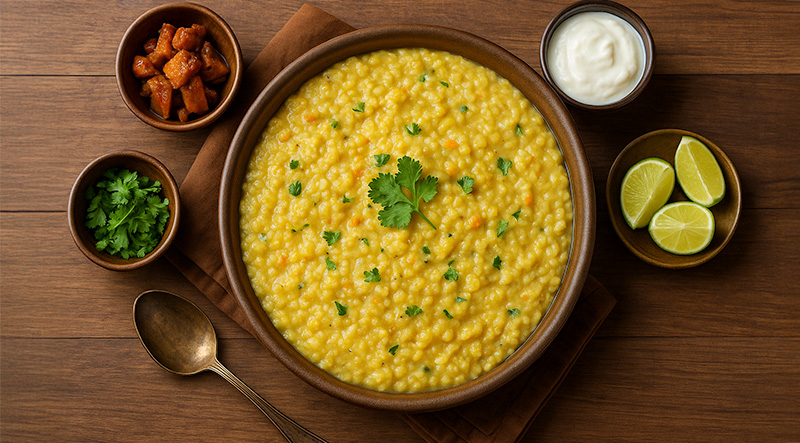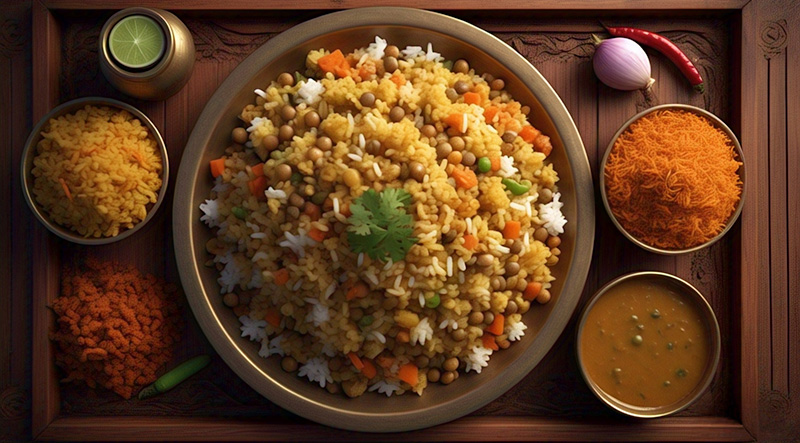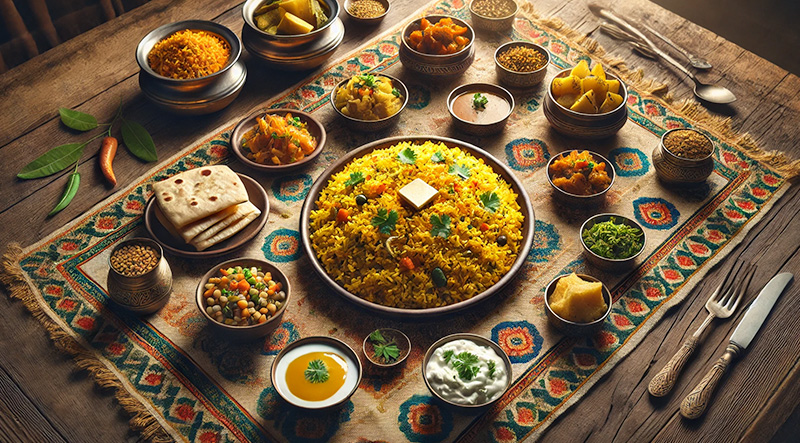Khichdi, the foundation of Indian home cooking, is golden, cozy, and incredibly nourishing. It is straightforward but incredibly fulfilling. This simple dish of rice and lentils, slow-cooked with aromatic spices and occasionally vegetables, is frequently referred to as India's version of comfort food and is a representation of coziness and well-being. Every spoonful of Khichdi's mild flavors and creamy texture promotes calmness, whether it's consumed during festive fasting, as a light meal for recuperation, or just as a soul-soothing dinner. It's a sense of home, not just food. Read More...
The History of Khichdi — India’s Timeless Comfort Dish:
Khichdi, a simple yet iconic dish of rice and lentils, has a history as rich and diverse as India itself. Often hailed as the country’s unofficial national dish, Khichdi transcends regions, religions, and social classes, making it a unifying culinary symbol across the subcontinent. Its origins date back thousands of years, with mentions in ancient Indian texts and records from foreign travelers who marveled at its wholesome simplicity.
Ancient Roots:
The earliest references to Khichdi can be traced to Ayurvedic texts and Sanskrit literature, where it was lauded as a sattvic food—pure, balanced, and easily digestible. The Charaka Samhita, a foundational text of Ayurveda, describes a dish akin to Khichdi as an ideal dietary option for healing and rejuvenation. Combining rice and mung dal (yellow lentils), it provided a complete protein source and was celebrated for promoting digestion and inner harmony.
From Royal Tables to Humble Kitchens:
Khichdi’s popularity was not confined to common households alone. During the Mughal era, it evolved from a plain staple into an elaborate preparation. The royal kitchens of the Mughals introduced ingredients like saffron, dried fruits, nuts, and ghee, giving rise to richer variations like “Shahi Khichdi.” Even the Turkish explorer Ibn Battuta, during his travels in India in the 14th century, noted a dish of rice and lentils resembling Khichdi being eaten widely across the region.
Regional Variations:
Over centuries, Khichdi has adapted itself to the tastes and ingredients of different Indian regions. In Bengal, it’s known as Khichuri and often served during festivals with fried vegetables. In Gujarat, a milder, ghee-rich version is a daily staple, while South India has its cousin in Pongal, flavored with black pepper and curry leaves. Each version carries the essence of its locale, yet retains the same base formula—grains and legumes cooked to a soft, porridge-like consistency.
A Symbol of Unity and Health:
In recent decades, Khichdi has gained official recognition for its cultural and nutritional significance. In 2017, the Indian government promoted Khichdi as a “Brand India” food at the World Food India event, highlighting its status as a symbol of unity in diversity. Its ease of preparation, health benefits, and adaptability to various diets—from vegan to gluten-free—make it a go-to dish in modern Indian households.
Conclusion:
From ancient scriptures to modern kitchens, Khichdi remains a beloved staple that speaks to India’s culinary heritage. Its enduring appeal lies in its simplicity, versatility, and emotional resonance—it’s the first solid food for babies, a comfort meal for the unwell, and a nostalgic reminder of home for many. In the story of Indian cuisine, Khichdi is not just a dish—it’s a legacy.
Toast the rice and dal (optional but flavorful):

Temper spices:
Build the base

Combine grains and liquid
Cook until soft

Finish and serve:
Tip:
The preparation and cooking time for Khichdi is relatively quick and easy. Preparing the ingredients—such as washing the rice and lentils, chopping vegetables (if using), and gathering spices—takes about 10 to 15 minutes. Cooking the Khichdi, depending on the consistency desired, takes approximately 25 to 30 minutes. Altogether, you can have a warm, comforting bowl of Khichdi ready in around 40 to 45 minutes.
A single serving of traditional Indian khichdi, based on the provided recipe using rice, moong dal, ghee, onions, tomatoes, and optional vegetables like carrots and peas, contains approximately 300–350 calories. This estimate includes around 1 tablespoon of ghee, moderate amounts of dal and rice, and basic vegetables. The calorie count can vary slightly depending on added garnishes like extra ghee, yogurt, or papad. Khichdi is considered a wholesome, balanced dish rich in complex carbs, plant-based protein, and dietary fiber.







